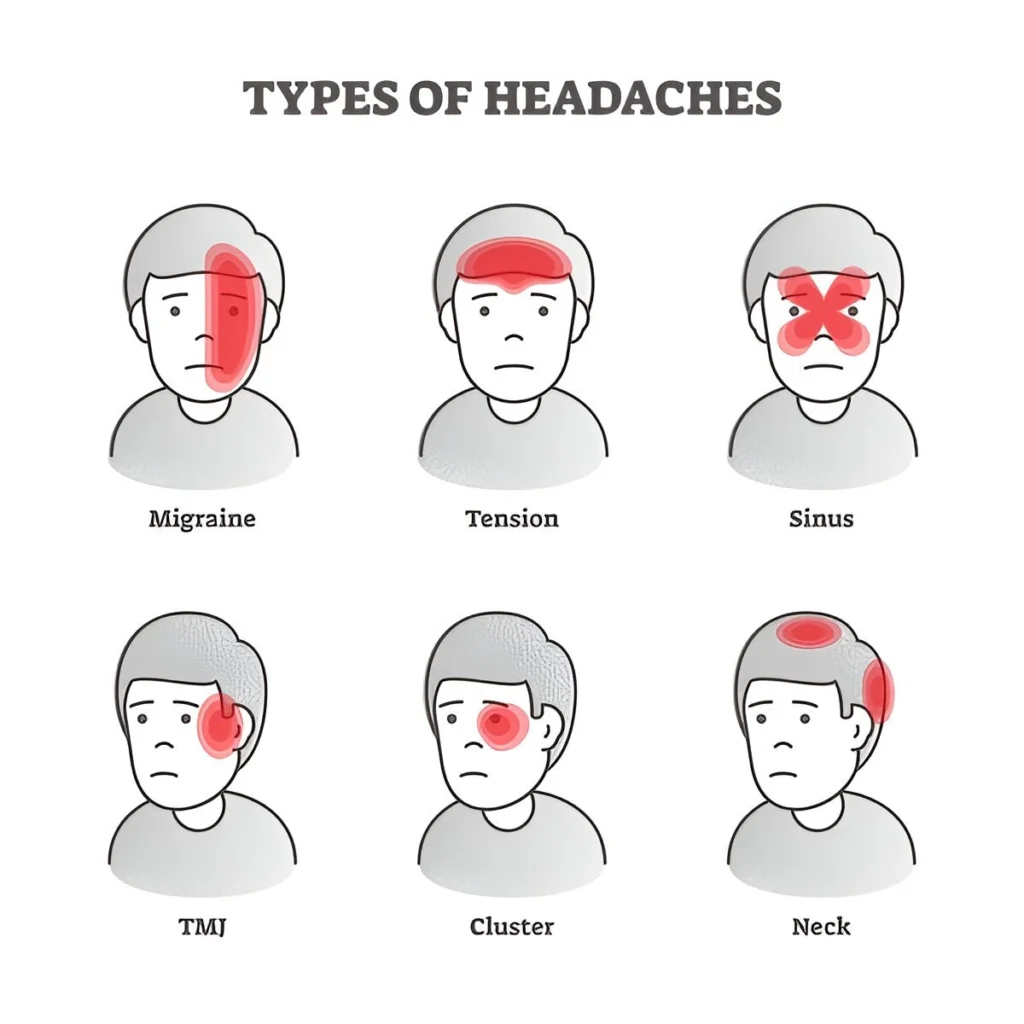Many people overlook the pillow when achieving restful sleep due to many factors. It may come as a question to you, ‘Is pillow a headache cause?’ The answer is yes, and there are many factors involved. In this, we’ll look at how the wrong type of pillow can cause headaches, what kind of pillows we have available, tips on choosing the right pillow, and more.
Understanding Headaches

Before seeing how pillows worsen headaches, we must understand what a headache is. Headaches can be mild to severe and are a prevalent ailment. There are many reasons that they can come, including tension, migraine, sinus, and so forth. However, the pain can occur anywhere in the head, sometimes associated with nausea or other light sensitivity.
Many Headache Subtypes
Slouching, emotional distress, and muscle overexertion are common causes of tension headaches. They typically have a dull ache that lingers for at least 30 minutes and, in rare cases, for days.

- Conversely, severe migraines may cause vomiting, nausea, and sensitivity to light and sound. Debilitating migraines can linger anywhere from a few hours to multiple days.
- Intense, painful headaches that strike in waves and tend to affect just one side of the brain are known as cluster headaches. Most have had acute discomfort and runny nose at some point.
- Sinus Headaches: These headaches can be related to sinus infections. They usually involve a painful or pressurized face. The pain can be profound and constant, sometimes right into the cheekbones, forehead, or bridge of the nose.
- Sleep Quality: The role of pillows in Sleep quality is greatly affected and can affect overall health. A soft pillow (Proper pillow) supports the head, neck, and spine. If you’re spine-aligned, you won’t wake up with pain, discomfort, and restful sleep. However, an unfavorable pillow (wrong pillow) can cause other problems and bad headaches.
Knowing what kind of headache you’re suffering from can help you understand what might be causing it, including your pillow.
What Causes a Headache Because of Pillows?
Here are a few factors that caused headaches from the different pillow types or pillow type:

- Poor Support: Bad pillows can strain necks if they don’t properly support the head. They can also shoot pain down to the head, causing headaches. Imagine if the pillow is too soft; the head will not be kept in the neutral position, causing misalignment.
- Incorrect Height: A pillow that is too high or too low can cause spinal misalignment. This tense misalignment can create tension in the neck and shoulders, which can also cause headaches. For example, a high pillow for a back sleeper may force forward, forward, straining the neck.
- Material Allergies: Some pillows are made with materials that can cause allergic reactions. Sinus pressure is an Allergy symptom that may cause sinus headaches. Pillows commonly contain allergens such as dust mites, mold, and synthetic materials.
- Worn-out Pillows: Pillows wear out over time. Worn-out pillows can cause discomfort and headaches when slept on. Your pillow has lumps, is flat, or has stopped being a pillow–it’s time to get a new one.
- Temperature Regulation: Some pillow materials hold excess heat and make sleeping uncomfortable. If you wake up feeling hot and painful, this can also cause tension headaches.
We recently reported five trial pillows compared with subjects’ ‘own’ pillows on waking cervical pain, where latex pillows were most likely associated with waking cervical pain (cervical spine pain), shoulder pain, neck pain (neck muscles pain), and feather pillows were most likely according to your sleep style.
Picking Out the Perfect Pillow

Having a good night’s sleep and avoiding headaches significantly improves with the correct pillow. Your body type, sleeping habits, preferences, and health status affect how comfortable a pillow is for you. To help you select the most suitable cushion, we have included the following guidelines:
1. Consider Your Sleep Position
- Back Sleepers: A medium-loft pillow supports the neck’s natural curve. These pillows help keep the spine aligned without pushing the head too forward.
- Side Sleepers: To fill the gap between the top of the head and shoulders, an additional pillow, a firmer, higher pillow, becomes necessary. This support helps maintain the spine in alignment, reducing neck strain.
- Stomach Sleepers: A soft, thinner pillow or no pillow can help avoid neck strain. The neck should be thin when the stomach sleeps because the stomach puts extra pressure on it.

2. Material Matters
Pillows come in different materials, each offering you support and comfort:
- Memory Foam Pillows: This popular material is shaped to conform to the contour of your head and neck, providing good support. Working on pressure points can help people with headaches, and memory foam pillows are a good choice.
- Latex: Firm support and is resistant to dust mites and mold. These create latex pillows that last longer and do not go down over time.
- Feather/Down: Soft and can be adjusted to sleepers but may not offer more than adequate support for some sleepers. These pillows mold to your desired shape but may compress too much for someone who needs firmer support.
- Buckwheat: Buckwheat pillows are supportive and adjustable, but the level of support may be too firm for some. They let the air pass through them, keeping you cool during the night.
- Cooling Gel: A few pillows, such as those with the added benefit of cooling gel to help regulate temperature, are upcycled from the material. But if you usually sleep hot, this pillow may help prevent you from becoming more uncomfortable.
3. Replace Regularly
- How long it takes depends on the material of the pillows and how much they are worn. Uncomfortable beds and worn-out pillows can cause headaches. This will help you keep support and hygiene fresh and replace your pillow regularly.
4. Test Before You Buy
- You should always test pillows in-store if you can. Take some time to simulate your sleeping position lie down and see if it’s comfortable and supportive. Many pillow retailers provide trial periods, allowing you to test the pillow at home.
A Comparison of Popular Pillow Types
| Feature | Memory Foam Pillows | Latex Pillows | Down Pillows | Synthetic Pillows |
|---|---|---|---|---|
| Material | Viscoelastic foam | Natural or synthetic latex | Down feathers | Synthetic fibers |
| Comfort | Conforms to body shape, pressure-relieving | Supportive and bouncy | Soft and plush | Soft and affordable |
| Support | Excellent support | Excellent support | Moderate support | Moderate support |
| Temperature Regulation | Can retain heat | Breathable and cool | Can be warm, but can be temperature-regulated | Breathable and cool |
| Allergy Friendliness | Hypoallergenic | Hypoallergenic | Can trigger allergies for some | Hypoallergenic |
| Maintenance | Spot clean or professional cleaning | Regular cleaning and airing | Regular cleaning and fluffing | Machine washable |
| Cost | Can be more expensive | More expensive | More expensive | Affordable |
Why not consider Hypoallergenic Options?
Hypoallergenic pillows: If you have allergies, you should use them. They are designed to hold back allergens and may help protect you against allergy-related headaches.
Additional Headache Prevention Tips
In addition to choosing the right pillow, consider these tips to help prevent headaches:

Maintain Good Posture
Good posture, whether sitting or standing, can lower stress on the neck and shoulders. Ergonomic chairs and desks can promote better posture during the day, keeping strain that can lead to headaches to a minimum.
Hydrate Regularly
Drink enough water throughout the day to prevent headaches and dehydration. Drink eight 8-ounce glasses of water daily, or more if you’re active or live in a hot climate.
Control Anxiety
To help you relax, try deep breathing exercises, yoga, or meditation. Effective stress management can improve a person’s health and reduce the frequency of tension headaches.
Cut Down on Screen Time
Yet, eye strain can develop from staring at screens for too long. The 20 20 20 guidelines can help you remember to take breaks: Take a 20-second break every 20 minutes to stare at anything 20 feet away. Minimizes strain on the eyes.
Create an Ambient That Promotes Restful Sleep
Verify that your bedroom promotes a restful night’s sleep. Maintain a cool, dark, and peaceful environment. Blackout curtains, a white noise machine, or earplugs might help you sleep better if you’re easily woken up.
Physical Activity continuously
Combined with regular physical exercise, this may lessen the likelihood of headaches. Aim to exercise moderately for at least half an hour on most days.
Stay On Top of Your Food Consumption
Some people have headaches after consuming particular meals or drinks. The causes include caffeine, alcohol, aged cheeses, and some portions of processed meats. Keeping a meal journal could help identify potential food triggers.
FAQs About Can Pillow Cause Headache

Does a pillow give you a headache?
An inappropriate or old pillow can cause neck strain and misalignment, leading to headaches and stiffness. A good pillow helps support the neck and head and is not uncomfortable.
What kind of pillow will stop headaches?
The usual recommendation is a medium-loft new pillow that supports your neck’s natural curve, but that can change depending on your sleep position. You can test different types to see what’s the best for you.
When should I change my pillow?
According to many, the best pillows to replace are those that have been with you for 1 to 2 years or an old pillow. This allows the support to stay fresh and prevents infection.
Do pillow allergies cause headaches?
Pillows can carry allergens that can lead to sinus pressure, severe headaches, and cluster headaches with muscle tension. If you’re sensitive to dust mites or mold, consider hypoallergenic options.
What else could have caused your headaches besides pillows?
Stress, dehydration, poor sleep quality, poor posture, and too much time spent staring at a screen can also cause headaches. If headache frequency can be addressed, these factors can be reduced.
Do certain pillow brands help ease headache pain?
Some brands are known for excellent designs and quality materials, though they are shaped according to personal preference. Tempur-Pedic, Coop Home Goods, and Purple are often praised for their supportive pillows, which lead to an excellent night’s sleep.
Is it normal to wake up with a headache or morning headaches?
Waking up with a headache isn’t uncommon, especially if your pillow isn’t providing the proper support. But if it happens regularly, then it might be time to start evaluating whether your pillow and your sleep habits are what they should be.
How does changing my pillow help with chronic headaches?
For certain people, changing to a soft pillow might ease the suffering of chronic and severe headaches. But of course, there are other things to consider, like stress management and hydration.
Conclusion
Therefore, in the end, we ask: “Can a pillow give you a headache? It is one that many will not think of, but it has a vital role in being healthy. A good pillow can make an enormous difference in sleep quality, preventing headaches and a lot of pain, while a lousy pillow does the opposite: It can make you uncomfortable and in pain. If you understand the relationship between pillows and headaches, you can choose to improve your sleep experience.

Choosing the right pillow for your needs, including whether you sleep on a side, front side, or back, is well worth it and can improve your sleep and reduce the incidence of headaches. But don’t forget to consider other factors like hydration, posture, and spin. With these tips, you’ll have restful nights and wake up headache-free for a more productive, pleasant day.
- Who Invented a Pillow? Evolution and Significance of Pillows - February 24, 2025
- Rattan Sofa Halbrund Perfect For Luxury and Comfort - February 19, 2025
- Sweet Dreams Pillow A Luxurious Sleep Experienc - February 16, 2025
